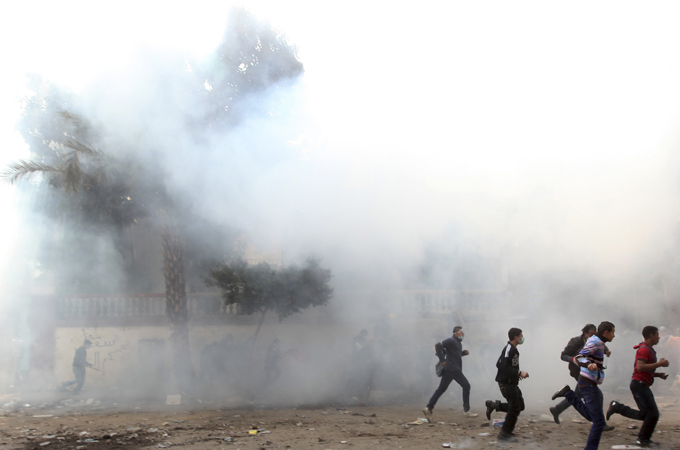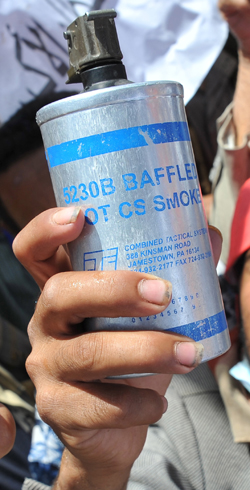
Egypt protesters say the recent tear gas used is different and 'stronger' from that fired at them in January [Reuters]
Fears That Tear Gas and Rubber Bullets, Widely Used In Crackdown Against Protesters, Could Be Cause Of Deaths In Egypt.
By Mujib Mashal
Last Modified: 23 Nov 2011 16:10
Courtesy Of "Al-Jazeera"
From Egypt, to Athens, to Oakland, police have employed "non-lethal weapons" to break down recent protests and disperse protesters.
As crowds have swelled to express discontent, variations of tear gas, rubber bullets, water cannons, and stun grenades have been fired back at them.
The US defence department describes non-lethal weapons as "primarily employed to immediately incapacitate targeted personnel or materiel, while minimising fatalities, permanent injury to personnel ... in the target area or environment.
 |
| Yemeni protesters display a Combined Systems tear gas canister [EPA] |
"Non-lethal weapons are intended to have reversible effects on personnel and material."
Despite this, activists have reported grave injuries as a result of tear gas canisters fired at protesters from close range.
Moreover, the non-lethality of the gas is also in doubt, as serious questions are being raised about the causes of recent deaths during this week's protests in Cairo's Tahrir square.
Al Jazeera’s Mike Hanna, reporting from the Egyptian capital, said:
"There have been repeated rounds of tear gas fired here. It is a particularly virulent form, stinging the face to an immense extent.
"Many of those who have been killed are said to have died of asphyxiation.
"Medical workers say the conditions of those brought in is serious, many with symptoms they have not seen before from tear gas inhalation."
Speaking to Al Jazeera, Khalid Hamdi, staffing a make-shift clinic in Tahrir square, said: “We've seen many faintings and we'd never seen that before.
"About 70 per cent of the injuries are fainting. People are coming in with asthma, convulsions sometimes - this wasn't often before."
Amnesty international has also expressed concern about the use of tear gas in the square.
"About 70 per cent of the injuries are fainting. People are coming in with asthma, convulsions sometimes - this wasn't often before."
Amnesty international has also expressed concern about the use of tear gas in the square.
"We have received reports from medical sources saying that some of those who died did so as as a result of suffocation after inhaling tear gas," Said Haddadi, a spokesman for the rights group, told Al Jazeera.
'Pain and Discomfort'
US government agencies, the departments of state and commmerce in particular, regulate the export of tear gas and other non-lethal weapons by granting export licenses allowing US manufacturers to sell tear gas to foreign buyers.
Two US companies have been identified as major exporters of the devices: Combined Systems Inc and NonLethal Technologies Inc, both based in Pennsylvania.
Peter Felstead, editor of Jane’s Defence Weekly, said countries buying weapons from the UK, at least, are closely vetted and their contracts constantly reviewed.
“If something happens in Saudi Arabia, or Bahrain for example, withdrawing contracts in response to those kind of events would present something of a dilemma. The US and UK strategic alliances with Saudi Arabia in particular are very strong. If there is unrest in Saudi, the question is will the support be withdrawn?"
He said buyers are expected to obtain training packages along with their purchase to make sure the weapons are employed properly. A lack of proper training could be the cause of any fatalities that might result.
"There are times when employing crowd control is absolutely necessary. But if the non-lethal weapons are not employed properly, they could make things worse.
"For example, if you end up forcing a crowd away from security forces to stampede through a narrow gap, you could kill people in the process."
What exactly is being fired at protesters in Tahrir is unclear.
Two forms of tear gas are most commonly used: Chlorobenzylidene malononitrile (also referred to as CS) and Chloroacetophenone (often known as CN).
Two forms of tear gas are most commonly used: Chlorobenzylidene malononitrile (also referred to as CS) and Chloroacetophenone (often known as CN).
Both gases are irritants that affect the eyes, nose, mouth and lungs, and cause tearing, sneezing and coughing.
"The primary effect is shortness of breath, pain, and discomfort," reads the catalogue of Combined Systems Inc.
Dr Ziad Kazzi, from Grady Health System and assistant director of Georgia Poison Center, said large doses of the gas could be fatal to healthy individuals as well.
“Those with already existing conditions, such as asthma or lung disease, are at higher risk. However, if large doses are inhaled, particularly in enclosed space, it could damage lungs and lead to death, even for healthy people. But it depends on the dosage.”
“Dose determines the poison,” he said, adding that several factors such as concentration, potency of the gas, the amount that is being delivered, the environment that it is being released in, and the personal characteristics of the people receiving it all play a part.
He said small doses have not been proven to have lasting effects.
He said small doses have not been proven to have lasting effects.
'A Cloud Of Irritant Agent'
Tear gas canisters come in various shapes and forms, for indoor and outdoor purposes.
Smoke grenades - both launched by hand as well as munitions launchers - "deliver a cloud of irritant agent with a discharge time of approximately 25 seconds," NonLethal Technologies Inc's catalogue says.
Smoke projectiles, the second method that tear gas can be used at protesters, are "designed to provide effective outdoor crowd dispersal while maintaining a safe stand-off distance of up to 80 yards," according to the catalogue.
The canisters weigh between 175 and 500 grammes, and are made of aluminum or stern steel. Much of the injuries are caused by the fact that these canisters are fired onto crowded areas.
"Danger: Do not fire directly at person[s]. Severe injury or death may result," is reportedly written on the canisters.
Rubber bullets have also been fired at protesters, causing severe injuries.
The bullets come in aluminum cartridges, with a total weight of about 185 grammes. In one of the models in the NonLethal Technologies catalogue, each cartridge contains "three rubber batons that are skip fired towards the subjects".
"Eyewitnesses and lawyers have told us that some were injured as a result of rubber bullets," Amnesty's Haddadi said about the use of rubber bullets in the protests in Cairo.
“People can be killed by rubber bullets, there is no doubt about that. It has happened in northern Ireland. If you fire from close range, or someone is hit in the head," Felstead said.
"It would be quite difficult to specifically target people lethally. But it could easily happen when firing into a crowd."
With over 36 killed in Egypt since November 19, and medical sources citing "suffocation after inhaling tear gas" as the cause of many of the deaths, the non-lethality of the weapons employed - as well as how they were imported - has come under serious question.
Khalid Abdala, an Egyptian actor and activist, told Al Jazeera from Tahrir that he held international governments "complicit in everything that is happening here".
"International governments have replenished the stocks of bullets that have been shot at people right now, and the tear gas that is clinging to my lungs," he said.




No comments:
Post a Comment